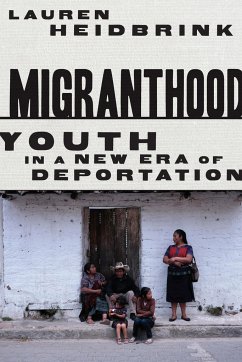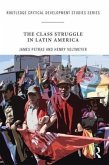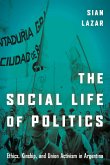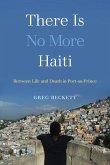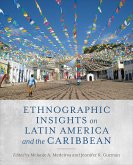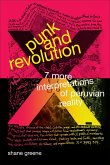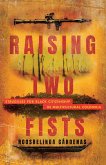- Broschiertes Buch
- Merkliste
- Auf die Merkliste
- Bewerten Bewerten
- Teilen
- Produkt teilen
- Produkterinnerung
- Produkterinnerung
Migranthood chronicles deportation from the perspectives of Indigenous youth who migrate unaccompanied from Guatemala to Mexico and the United States. In communities of origin in Guatemala, zones of transit in Mexico, detention centers for children in the U.S., government facilities receiving returned children in Guatemala, and communities of return, young people share how they negotiate everyday violence and discrimination, how they and their families prioritize limited resources and make difficult decisions, and how they develop and sustain relationships over time and space. Anthropologist…mehr
Andere Kunden interessierten sich auch für
![Digital Pirates Digital Pirates]() Alexander Sebastian DentDigital Pirates33,99 €
Alexander Sebastian DentDigital Pirates33,99 €![The Class Struggle in Latin America The Class Struggle in Latin America]() James PetrasThe Class Struggle in Latin America67,99 €
James PetrasThe Class Struggle in Latin America67,99 €![The Social Life of Politics The Social Life of Politics]() Sian LazarThe Social Life of Politics33,99 €
Sian LazarThe Social Life of Politics33,99 €![There Is No More Haiti There Is No More Haiti]() Greg BeckettThere Is No More Haiti33,99 €
Greg BeckettThere Is No More Haiti33,99 €![Ethnographic Insights on Latin America and the Caribbean Ethnographic Insights on Latin America and the Caribbean]() Melanie A MedeirosEthnographic Insights on Latin America and the Caribbean74,99 €
Melanie A MedeirosEthnographic Insights on Latin America and the Caribbean74,99 €![Punk and Revolution Punk and Revolution]() Shane GreenePunk and Revolution44,99 €
Shane GreenePunk and Revolution44,99 €![Raising Two Fists Raising Two Fists]() Roosbelinda CárdenasRaising Two Fists36,99 €
Roosbelinda CárdenasRaising Two Fists36,99 €-
-
-
Migranthood chronicles deportation from the perspectives of Indigenous youth who migrate unaccompanied from Guatemala to Mexico and the United States. In communities of origin in Guatemala, zones of transit in Mexico, detention centers for children in the U.S., government facilities receiving returned children in Guatemala, and communities of return, young people share how they negotiate everyday violence and discrimination, how they and their families prioritize limited resources and make difficult decisions, and how they develop and sustain relationships over time and space. Anthropologist Lauren Heidbrink shows that Indigenous youth cast as objects of policy, not participants, are not passive recipients of securitization policies and development interventions. Instead, Indigenous youth draw from a rich social, cultural, and political repertoire of assets and tactics to navigate precarity and marginality in Guatemala, including transnational kin, social networks, and financial institutions. By attending to young people's perspectives, we learn the critical roles they play as contributors to household economies, local social practices, and global processes. The insights and experiences of young people uncover the transnational effects of securitized responses to migration management and development on individuals and families, across space, citizenship status, and generation. They likewise provide evidence to inform child protection and human rights locally and internationally.
Hinweis: Dieser Artikel kann nur an eine deutsche Lieferadresse ausgeliefert werden.
Hinweis: Dieser Artikel kann nur an eine deutsche Lieferadresse ausgeliefert werden.
Produktdetails
- Produktdetails
- Verlag: Stanford University Press
- Seitenzahl: 240
- Erscheinungstermin: 28. April 2020
- Englisch
- Abmessung: 226mm x 150mm x 20mm
- Gewicht: 386g
- ISBN-13: 9781503612075
- ISBN-10: 1503612074
- Artikelnr.: 57164998
- Herstellerkennzeichnung
- Libri GmbH
- Europaallee 1
- 36244 Bad Hersfeld
- 06621 890
- Verlag: Stanford University Press
- Seitenzahl: 240
- Erscheinungstermin: 28. April 2020
- Englisch
- Abmessung: 226mm x 150mm x 20mm
- Gewicht: 386g
- ISBN-13: 9781503612075
- ISBN-10: 1503612074
- Artikelnr.: 57164998
- Herstellerkennzeichnung
- Libri GmbH
- Europaallee 1
- 36244 Bad Hersfeld
- 06621 890
Lauren Heidbrink is Associate Professor of Human Development at California State University, Long Beach. She is the author of Migrant Youth, Transnational Families, and the State: Care and Contested Interests (2014).
Contents and Abstracts
Introduction
chapter abstract
This chapter introduces the book's three main arguments. First, the
narratives of migrant and deported youth challenge the ways that the law
and public policy homogenize the complex, multifaceted, and varied
experiences of young migrants. Second, securitized approaches to migration
management, often under the guise of "development," is a mode of governance
that moves across and beyond geopolitical space, increasingly ensnaring
children and youth in this global immigration dragnet. Third, in Central
America, Indigenous communities are disproportionately impacted by the
adverse consequences of the securitization of migration management
revealing the enduring and transnational reach of public policy across
geopolitical space and generation. By interrogating how violence is
produced and practiced across borders and how Indigenous youth navigate
this violence following deportation, Heidbrink rethinks how and why youth
are on the move. The chapter describes the mixed-methods enlisted in this
5-year, multi-sited study and outlines the forthcoming chapters.
1Youth as Agents, Caregivers, and Migrants
chapter abstract
Seemingly new patterns of migration among Central American children suggest
that young people are engaged in intergenerational survival strategies that
are increasingly transnational and youth-led. Enlisting multi-sited
ethnography with young people and their families across the U.S., Mexico
and Guatemala, this chapter examines how young people enlist social agency
through their care work, paid labor, and mobility. As seasonal, regional
and transnational migrants, young people enlist migration as a collective
and historically-rooted survival strategy that responds to their past
experiences of violence and marginalization and to their present and future
needs. In tracing the ways young people enact care and belonging through
social and physical mobility, this chapter argues that the contemporary
transnational migration of Indigenous youth is a cultural elaboration of
care, one rooted in historical displacements of Indigenous communities.
2Widening the Frame
chapter abstract
Chapter two utilizes the method of multi-media elicitation with young
people to dissect discourses that emerged from official media campaigns
intended to deter child migration. Youth identifies the ways these official
messages infantilize young people, criminalize their parents, and
pathologize migration. Analyzing discourses about youth alongside
narratives by youth reveals the consequential disconnect between the
imagined and lived experiences of young people and their families. In
critiquing the campaign and its many pitfalls, young people widen the frame
of reference by alternatively interpreting the reasons for and consequences
of migration and deportation. In so doing, they evaluate the efficacy of
policy responses to child migration in Central America.
3The Making of a Crisis
chapter abstract
In spite of media headlines which claim that child migration is the crisis
du jour, chapter three argues that the influx of young migrants in 2014 and
2018 are policy-made crises. Chapter three situates the testimonio of
Liseth, a Mam woman who was a refugee in Mexico as a child, alongside key
historical and contemporary policy initiatives to illustrate how
colonialism, armed conflict, the proliferation of plantations, and
extractive industries have displaced Indigenous communities across
generations. The chapter argues that these displacements are emblematic of
the growing securitization of migration management and of development aid
in "post-conflict" Guatemala. Key policies analyzed include the Southern
Border Program, the Central American Minors program, and the Plan for the
Alliance for Prosperity. Ultimately, the chapter contends that the
securitization of aid spurs rather than deters migration.
4¿Quédate y qué?
chapter abstract
Chapter four analyzes how discourses about child migration seep into
government interventions and institutional practice and how young people
experience them. The chapter begins by recounting the narrative of
16-year-old Delia as she is deported from a U.S. facility for unaccompanied
children to a government processing center in Guatemala City. The chapter
continues with the examination of development initiatives that explicitly
claim to support returned youth like Delia, to reintegrate them into
communities, and to create alternatives to (re)migration. These development
initiatives not only fail to effectively support young people but also
reinforce long-standing social hierarchies between the ladino (mixed-race)
elite and Indigenous communities in Guatemala.
5Negotiating Returns
chapter abstract
Chapter five examines how young people variously experience removal
following deportation-as children of deported parents or madres y padres
deportados; as U.S. citizen children who arrive in Guatemala as they
accompany their parents following removal or as llegadas; and as
unaccompanied children who are deported as retornados. The in-depth
narratives of young people focus on the social, emotional, and financial
impacts of removal on intimate, familial relationships over time.
Conceptually, these diverse and multiple experiences of removal allow us to
recognize the depth and breadth of deportation's impacts on young people
and their families. The chapter argues that deportation is a process, one
with rippling effects on individuals and families over time and
geopolitical space.
6Debt and Indebtedness
chapter abstract
Moving beyond the individual and familial impacts of migration and
deportation, Chapter six details the community-level impacts of
securitization and development in the highland town of Almolonga. Known as
the "breadbasket" of Central America, Almolonga enjoys a thriving
agricultural economy including abundant employment opportunities given the
multiple seasons of crops, selling in local markets, and commerce to and
from Mexico and El Salvador. Yet, the migration of young people continues
unabated. Enlisting a household survey, this chapter examines local
critiques of development and explores how community members alternatively
navigate precarity through the growing use of credit and debt, often with
detrimental effects across generations.
7El derecho a no migrar
chapter abstract
Chapter seven reflects on the policy lessons learned from Indigenous youth,
arguing that there is an urgent need for rigorous, publicly-accessible, and
engaged research. The book concludes with the ways young people envision
"the right to not migrate" as a transformative process that aspires to 'el
buen vivir (the good life)', an Indigenous political project rooted in the
valorization of Indigenous ways of knowing and the advancement of a
collective well-being, broadly conceived. Young people link internal and
community-based decolonizing projects as critical to broader social and,
indeed, global transformation.
Introduction
chapter abstract
This chapter introduces the book's three main arguments. First, the
narratives of migrant and deported youth challenge the ways that the law
and public policy homogenize the complex, multifaceted, and varied
experiences of young migrants. Second, securitized approaches to migration
management, often under the guise of "development," is a mode of governance
that moves across and beyond geopolitical space, increasingly ensnaring
children and youth in this global immigration dragnet. Third, in Central
America, Indigenous communities are disproportionately impacted by the
adverse consequences of the securitization of migration management
revealing the enduring and transnational reach of public policy across
geopolitical space and generation. By interrogating how violence is
produced and practiced across borders and how Indigenous youth navigate
this violence following deportation, Heidbrink rethinks how and why youth
are on the move. The chapter describes the mixed-methods enlisted in this
5-year, multi-sited study and outlines the forthcoming chapters.
1Youth as Agents, Caregivers, and Migrants
chapter abstract
Seemingly new patterns of migration among Central American children suggest
that young people are engaged in intergenerational survival strategies that
are increasingly transnational and youth-led. Enlisting multi-sited
ethnography with young people and their families across the U.S., Mexico
and Guatemala, this chapter examines how young people enlist social agency
through their care work, paid labor, and mobility. As seasonal, regional
and transnational migrants, young people enlist migration as a collective
and historically-rooted survival strategy that responds to their past
experiences of violence and marginalization and to their present and future
needs. In tracing the ways young people enact care and belonging through
social and physical mobility, this chapter argues that the contemporary
transnational migration of Indigenous youth is a cultural elaboration of
care, one rooted in historical displacements of Indigenous communities.
2Widening the Frame
chapter abstract
Chapter two utilizes the method of multi-media elicitation with young
people to dissect discourses that emerged from official media campaigns
intended to deter child migration. Youth identifies the ways these official
messages infantilize young people, criminalize their parents, and
pathologize migration. Analyzing discourses about youth alongside
narratives by youth reveals the consequential disconnect between the
imagined and lived experiences of young people and their families. In
critiquing the campaign and its many pitfalls, young people widen the frame
of reference by alternatively interpreting the reasons for and consequences
of migration and deportation. In so doing, they evaluate the efficacy of
policy responses to child migration in Central America.
3The Making of a Crisis
chapter abstract
In spite of media headlines which claim that child migration is the crisis
du jour, chapter three argues that the influx of young migrants in 2014 and
2018 are policy-made crises. Chapter three situates the testimonio of
Liseth, a Mam woman who was a refugee in Mexico as a child, alongside key
historical and contemporary policy initiatives to illustrate how
colonialism, armed conflict, the proliferation of plantations, and
extractive industries have displaced Indigenous communities across
generations. The chapter argues that these displacements are emblematic of
the growing securitization of migration management and of development aid
in "post-conflict" Guatemala. Key policies analyzed include the Southern
Border Program, the Central American Minors program, and the Plan for the
Alliance for Prosperity. Ultimately, the chapter contends that the
securitization of aid spurs rather than deters migration.
4¿Quédate y qué?
chapter abstract
Chapter four analyzes how discourses about child migration seep into
government interventions and institutional practice and how young people
experience them. The chapter begins by recounting the narrative of
16-year-old Delia as she is deported from a U.S. facility for unaccompanied
children to a government processing center in Guatemala City. The chapter
continues with the examination of development initiatives that explicitly
claim to support returned youth like Delia, to reintegrate them into
communities, and to create alternatives to (re)migration. These development
initiatives not only fail to effectively support young people but also
reinforce long-standing social hierarchies between the ladino (mixed-race)
elite and Indigenous communities in Guatemala.
5Negotiating Returns
chapter abstract
Chapter five examines how young people variously experience removal
following deportation-as children of deported parents or madres y padres
deportados; as U.S. citizen children who arrive in Guatemala as they
accompany their parents following removal or as llegadas; and as
unaccompanied children who are deported as retornados. The in-depth
narratives of young people focus on the social, emotional, and financial
impacts of removal on intimate, familial relationships over time.
Conceptually, these diverse and multiple experiences of removal allow us to
recognize the depth and breadth of deportation's impacts on young people
and their families. The chapter argues that deportation is a process, one
with rippling effects on individuals and families over time and
geopolitical space.
6Debt and Indebtedness
chapter abstract
Moving beyond the individual and familial impacts of migration and
deportation, Chapter six details the community-level impacts of
securitization and development in the highland town of Almolonga. Known as
the "breadbasket" of Central America, Almolonga enjoys a thriving
agricultural economy including abundant employment opportunities given the
multiple seasons of crops, selling in local markets, and commerce to and
from Mexico and El Salvador. Yet, the migration of young people continues
unabated. Enlisting a household survey, this chapter examines local
critiques of development and explores how community members alternatively
navigate precarity through the growing use of credit and debt, often with
detrimental effects across generations.
7El derecho a no migrar
chapter abstract
Chapter seven reflects on the policy lessons learned from Indigenous youth,
arguing that there is an urgent need for rigorous, publicly-accessible, and
engaged research. The book concludes with the ways young people envision
"the right to not migrate" as a transformative process that aspires to 'el
buen vivir (the good life)', an Indigenous political project rooted in the
valorization of Indigenous ways of knowing and the advancement of a
collective well-being, broadly conceived. Young people link internal and
community-based decolonizing projects as critical to broader social and,
indeed, global transformation.
Contents and Abstracts
Introduction
chapter abstract
This chapter introduces the book's three main arguments. First, the
narratives of migrant and deported youth challenge the ways that the law
and public policy homogenize the complex, multifaceted, and varied
experiences of young migrants. Second, securitized approaches to migration
management, often under the guise of "development," is a mode of governance
that moves across and beyond geopolitical space, increasingly ensnaring
children and youth in this global immigration dragnet. Third, in Central
America, Indigenous communities are disproportionately impacted by the
adverse consequences of the securitization of migration management
revealing the enduring and transnational reach of public policy across
geopolitical space and generation. By interrogating how violence is
produced and practiced across borders and how Indigenous youth navigate
this violence following deportation, Heidbrink rethinks how and why youth
are on the move. The chapter describes the mixed-methods enlisted in this
5-year, multi-sited study and outlines the forthcoming chapters.
1Youth as Agents, Caregivers, and Migrants
chapter abstract
Seemingly new patterns of migration among Central American children suggest
that young people are engaged in intergenerational survival strategies that
are increasingly transnational and youth-led. Enlisting multi-sited
ethnography with young people and their families across the U.S., Mexico
and Guatemala, this chapter examines how young people enlist social agency
through their care work, paid labor, and mobility. As seasonal, regional
and transnational migrants, young people enlist migration as a collective
and historically-rooted survival strategy that responds to their past
experiences of violence and marginalization and to their present and future
needs. In tracing the ways young people enact care and belonging through
social and physical mobility, this chapter argues that the contemporary
transnational migration of Indigenous youth is a cultural elaboration of
care, one rooted in historical displacements of Indigenous communities.
2Widening the Frame
chapter abstract
Chapter two utilizes the method of multi-media elicitation with young
people to dissect discourses that emerged from official media campaigns
intended to deter child migration. Youth identifies the ways these official
messages infantilize young people, criminalize their parents, and
pathologize migration. Analyzing discourses about youth alongside
narratives by youth reveals the consequential disconnect between the
imagined and lived experiences of young people and their families. In
critiquing the campaign and its many pitfalls, young people widen the frame
of reference by alternatively interpreting the reasons for and consequences
of migration and deportation. In so doing, they evaluate the efficacy of
policy responses to child migration in Central America.
3The Making of a Crisis
chapter abstract
In spite of media headlines which claim that child migration is the crisis
du jour, chapter three argues that the influx of young migrants in 2014 and
2018 are policy-made crises. Chapter three situates the testimonio of
Liseth, a Mam woman who was a refugee in Mexico as a child, alongside key
historical and contemporary policy initiatives to illustrate how
colonialism, armed conflict, the proliferation of plantations, and
extractive industries have displaced Indigenous communities across
generations. The chapter argues that these displacements are emblematic of
the growing securitization of migration management and of development aid
in "post-conflict" Guatemala. Key policies analyzed include the Southern
Border Program, the Central American Minors program, and the Plan for the
Alliance for Prosperity. Ultimately, the chapter contends that the
securitization of aid spurs rather than deters migration.
4¿Quédate y qué?
chapter abstract
Chapter four analyzes how discourses about child migration seep into
government interventions and institutional practice and how young people
experience them. The chapter begins by recounting the narrative of
16-year-old Delia as she is deported from a U.S. facility for unaccompanied
children to a government processing center in Guatemala City. The chapter
continues with the examination of development initiatives that explicitly
claim to support returned youth like Delia, to reintegrate them into
communities, and to create alternatives to (re)migration. These development
initiatives not only fail to effectively support young people but also
reinforce long-standing social hierarchies between the ladino (mixed-race)
elite and Indigenous communities in Guatemala.
5Negotiating Returns
chapter abstract
Chapter five examines how young people variously experience removal
following deportation-as children of deported parents or madres y padres
deportados; as U.S. citizen children who arrive in Guatemala as they
accompany their parents following removal or as llegadas; and as
unaccompanied children who are deported as retornados. The in-depth
narratives of young people focus on the social, emotional, and financial
impacts of removal on intimate, familial relationships over time.
Conceptually, these diverse and multiple experiences of removal allow us to
recognize the depth and breadth of deportation's impacts on young people
and their families. The chapter argues that deportation is a process, one
with rippling effects on individuals and families over time and
geopolitical space.
6Debt and Indebtedness
chapter abstract
Moving beyond the individual and familial impacts of migration and
deportation, Chapter six details the community-level impacts of
securitization and development in the highland town of Almolonga. Known as
the "breadbasket" of Central America, Almolonga enjoys a thriving
agricultural economy including abundant employment opportunities given the
multiple seasons of crops, selling in local markets, and commerce to and
from Mexico and El Salvador. Yet, the migration of young people continues
unabated. Enlisting a household survey, this chapter examines local
critiques of development and explores how community members alternatively
navigate precarity through the growing use of credit and debt, often with
detrimental effects across generations.
7El derecho a no migrar
chapter abstract
Chapter seven reflects on the policy lessons learned from Indigenous youth,
arguing that there is an urgent need for rigorous, publicly-accessible, and
engaged research. The book concludes with the ways young people envision
"the right to not migrate" as a transformative process that aspires to 'el
buen vivir (the good life)', an Indigenous political project rooted in the
valorization of Indigenous ways of knowing and the advancement of a
collective well-being, broadly conceived. Young people link internal and
community-based decolonizing projects as critical to broader social and,
indeed, global transformation.
Introduction
chapter abstract
This chapter introduces the book's three main arguments. First, the
narratives of migrant and deported youth challenge the ways that the law
and public policy homogenize the complex, multifaceted, and varied
experiences of young migrants. Second, securitized approaches to migration
management, often under the guise of "development," is a mode of governance
that moves across and beyond geopolitical space, increasingly ensnaring
children and youth in this global immigration dragnet. Third, in Central
America, Indigenous communities are disproportionately impacted by the
adverse consequences of the securitization of migration management
revealing the enduring and transnational reach of public policy across
geopolitical space and generation. By interrogating how violence is
produced and practiced across borders and how Indigenous youth navigate
this violence following deportation, Heidbrink rethinks how and why youth
are on the move. The chapter describes the mixed-methods enlisted in this
5-year, multi-sited study and outlines the forthcoming chapters.
1Youth as Agents, Caregivers, and Migrants
chapter abstract
Seemingly new patterns of migration among Central American children suggest
that young people are engaged in intergenerational survival strategies that
are increasingly transnational and youth-led. Enlisting multi-sited
ethnography with young people and their families across the U.S., Mexico
and Guatemala, this chapter examines how young people enlist social agency
through their care work, paid labor, and mobility. As seasonal, regional
and transnational migrants, young people enlist migration as a collective
and historically-rooted survival strategy that responds to their past
experiences of violence and marginalization and to their present and future
needs. In tracing the ways young people enact care and belonging through
social and physical mobility, this chapter argues that the contemporary
transnational migration of Indigenous youth is a cultural elaboration of
care, one rooted in historical displacements of Indigenous communities.
2Widening the Frame
chapter abstract
Chapter two utilizes the method of multi-media elicitation with young
people to dissect discourses that emerged from official media campaigns
intended to deter child migration. Youth identifies the ways these official
messages infantilize young people, criminalize their parents, and
pathologize migration. Analyzing discourses about youth alongside
narratives by youth reveals the consequential disconnect between the
imagined and lived experiences of young people and their families. In
critiquing the campaign and its many pitfalls, young people widen the frame
of reference by alternatively interpreting the reasons for and consequences
of migration and deportation. In so doing, they evaluate the efficacy of
policy responses to child migration in Central America.
3The Making of a Crisis
chapter abstract
In spite of media headlines which claim that child migration is the crisis
du jour, chapter three argues that the influx of young migrants in 2014 and
2018 are policy-made crises. Chapter three situates the testimonio of
Liseth, a Mam woman who was a refugee in Mexico as a child, alongside key
historical and contemporary policy initiatives to illustrate how
colonialism, armed conflict, the proliferation of plantations, and
extractive industries have displaced Indigenous communities across
generations. The chapter argues that these displacements are emblematic of
the growing securitization of migration management and of development aid
in "post-conflict" Guatemala. Key policies analyzed include the Southern
Border Program, the Central American Minors program, and the Plan for the
Alliance for Prosperity. Ultimately, the chapter contends that the
securitization of aid spurs rather than deters migration.
4¿Quédate y qué?
chapter abstract
Chapter four analyzes how discourses about child migration seep into
government interventions and institutional practice and how young people
experience them. The chapter begins by recounting the narrative of
16-year-old Delia as she is deported from a U.S. facility for unaccompanied
children to a government processing center in Guatemala City. The chapter
continues with the examination of development initiatives that explicitly
claim to support returned youth like Delia, to reintegrate them into
communities, and to create alternatives to (re)migration. These development
initiatives not only fail to effectively support young people but also
reinforce long-standing social hierarchies between the ladino (mixed-race)
elite and Indigenous communities in Guatemala.
5Negotiating Returns
chapter abstract
Chapter five examines how young people variously experience removal
following deportation-as children of deported parents or madres y padres
deportados; as U.S. citizen children who arrive in Guatemala as they
accompany their parents following removal or as llegadas; and as
unaccompanied children who are deported as retornados. The in-depth
narratives of young people focus on the social, emotional, and financial
impacts of removal on intimate, familial relationships over time.
Conceptually, these diverse and multiple experiences of removal allow us to
recognize the depth and breadth of deportation's impacts on young people
and their families. The chapter argues that deportation is a process, one
with rippling effects on individuals and families over time and
geopolitical space.
6Debt and Indebtedness
chapter abstract
Moving beyond the individual and familial impacts of migration and
deportation, Chapter six details the community-level impacts of
securitization and development in the highland town of Almolonga. Known as
the "breadbasket" of Central America, Almolonga enjoys a thriving
agricultural economy including abundant employment opportunities given the
multiple seasons of crops, selling in local markets, and commerce to and
from Mexico and El Salvador. Yet, the migration of young people continues
unabated. Enlisting a household survey, this chapter examines local
critiques of development and explores how community members alternatively
navigate precarity through the growing use of credit and debt, often with
detrimental effects across generations.
7El derecho a no migrar
chapter abstract
Chapter seven reflects on the policy lessons learned from Indigenous youth,
arguing that there is an urgent need for rigorous, publicly-accessible, and
engaged research. The book concludes with the ways young people envision
"the right to not migrate" as a transformative process that aspires to 'el
buen vivir (the good life)', an Indigenous political project rooted in the
valorization of Indigenous ways of knowing and the advancement of a
collective well-being, broadly conceived. Young people link internal and
community-based decolonizing projects as critical to broader social and,
indeed, global transformation.

